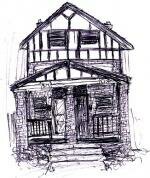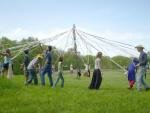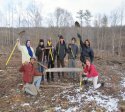The Leaves of Twin Oaks #116
 |
||||||||||||
News of the Oaks Issue #116
The Wheel has been turning at Twin Oaks, as we've marked both birth and death in the community. We welcomed two new babies into the community, Sylvia and Grace (in June and October). Both are healthy, glowing baby girls, and many communards are happily taking turns ooh-ing and aah-ing over them. We also lost a member, when Piper, aged 89, died during the night in early November. Piper was the member who had moved here earlier than anyone else, in the late 60's. At her funeral at our graveyard, many members spoke about her intense dedication to The Reading Window, a program she had developed to help children learn to read effectively. Piper was also a pioneer in helping Twin Oaks approach issues of aging in the community, and her presence is missed. (Read more about Piper and how Twin Oaks deals with death elsewhere in this issue.)
|
||||||||||||
We've had a lot of inter-community connections recently. Our sister community Acorn had a fire that took out their main community kitchen and severely affected their primary residence. We've been helping by sending over our own members to do repair work and also offering housing (which Acorn is now short on) for outside friends who are donating their time and construction skills. We also sent a group of members to East Wind Community in Missouri to help with "Tahini Week". As part of East Wind's nut-butter business, they have a "push" to process a lot of tahini (sesame paste) all at once. Lastly, several ex-Twin Oakers who have been living at Acorn founded a fourth community in Louisa county, branching off from Acorn into the appropriately-named "Sapling" community.
We've also had some international connections. Each year, we host about 75 people in our Visitor Program. This year we were blessed with visitors from France, Korea, Lebanon, Canada, the Cayman Islands and the Czech Republic. Also, all three FEC communities in the Louisa, VA area (Twin Oaks, Acorn and Living Energy Farm) have a representative at the South Pole this winter! A member from each community (the three of them are friends) is spending several months working at the South Pole, doing cooking and IT support work.
Publishing Mania: we've had several people here publish what might be described as their Magnum Opus. Ira has published Vegetable Gardening in the Southeast, based on her decades of experience growing food. Alexis-X has published an updated and revised edition of Integrated Activism: Applying the Hidden Connections Between Ecology, Economy, Politics and Social Progress which contains a large portion of all the cultural analysis your heart could desire. And Cameron is working on a webpage (kayakgreenland1959.wordpress.com) about his experiences in Greenland in 1959, where he spent three months learning kayak hunting from the native Inuit. He has documented his experiences, with a great many of his photographs, for others for others to learn from.
Other random happenings: our annual Communities Conference and Women's Gathering both happened, and over 250 people attended those events. Our Yard Manager has taken a new approach, and the courtyard is now graced with some outstanding boxwood topiary, including a five-foot high cat, a two-foot high chicken, and a peaceful Buddha greeting people as they enter the Herb Garden. In December, our one-month Dominion (the card game) tournament held its opening ceremonies, complete with outrageous outfits and silly speechifying. About 20 members are playing, each with their own Dominion alter-ego name they'll use for the duration of the tournament.

Cat and Chicken Boxwoods outside Llano Kitchen |
The Alternative Culture of Death
by Valerie
In November, Twin Oaks lost a brightly-shining star from the constellation of our membership. Our oldest member, Piper, was discovered having died in the night. At age 89, this was not entirely unexpected, but Piper had a particular zest for life. She was a powerful force for her various passions. A life-long teacher, she had developed a system for teaching children to read called "The Reading Window", and you only had to spend a short time with her before you'd be hearing about her latest students' successes and her fierce pride in them. She was very political, and was active in local politics up until the election that occurred only days before her death.
We buried Piper in our graveyard, as we've buried members before her. We work with our local funeral home so that people can be buried without embalming, in a wooden coffin that we have built ourselves (both of which Virginia laws allow). In our practices with death as in life, we do not want to be putting chemicals or substances into the ground that are not healthy for the earth.
|
|

|
For a burial, we'll prepare ahead of time by digging a grave either by hand or with our backhoe. On the day of the funeral, we gather and process from the main community to the graveyard. Generally, the group is made up of community members, family, and ex-members and friends from off-the-farm. As with so many aspects of Twin Oaks, a funeral here is a relatively collectively-organized affair. Each person who wishes to will talk about their favourite memories of the person, share what they learned from that person or what they'll miss about them. Then the coffin is lowered and we all help with the actual burial, using shovels to cover the coffin with dirt, perhaps tossing in some flowers. Afterwards we'll have a gathering, a "wake", which often functions as a reunion of sorts, as funerals everywhere tend to do.
Each person that is buried in the graveyard marks a loss for the community. But we can take solace in the fact that we are able to mark each person's final connection to the community in a way that is in line with our values. If we really want to create an alternative society, we need to include all stages of human life. Most mainstream institutions that deal with various life stages--hospitals for birth, schools for education, businesses for employment and funeral homes for death--have other (often financial) interests to maintain and often place those priorities above the health of the individual, the earth and wider society. At Twin Oaks we are grateful to be able to engage in these life stages in ways that are firmly rooted in our alternative values. And in this case, it is once again Piper who is leading the way, bringing us ever closer to the revolution.
The Twin Oaks Library
by Mala
After I graduated college (with a highly employable degree in literature / gender studies), I did the standard post-college thing of working random office jobs while thinking about what I actually wanted to do with my life. The two options that interested me most were moving to community or going to school in library science. I looked into some MLS programs but was intimidated by the way they were morphing into Information Technology programs. I'd naively imagined that library school would offer classes like "Helping People Find Books They Like"; instead, the classes all had titles like "Database Architecture." Yuck.

Mala |
So community won out. When I moved here Jake had been the community librarian for about 25 years with no sign of leaving. When he eventually did decide to leave the community, we were all heartbroken; but my heartbreak was leavened with glee at getting to combine the two life paths I'd contemplated.
The first task I took on was reorganizing our collection of slightly over 11,000 books; I decided to Dewey Decimalize them. The library has a small labor budget, only an hour or two a week, so I projected that my reorganization would take 5 years, but it only took 3. (People thought I was insane for doing this. Maybe I am. But having it all Dewey Decimalized makes me very happy.)
The library functions in typical Twin Oaks style, in that the boundary between public and private is deliberately very porous. There is no catalog or sign-out system; members help themselves to whatever they want, keep books however long they want to, return them if and when they want to. We don't have to be controlling with the books, because my main job as librarian is creating enough space to handle the steady influx of donations from members, ex-members, and friends. (Please don't respond to this article by sending books without getting in touch first!) When I first became librarian, it seemed that every new member moved here with a dowry of Tom Robbins and J.D. Salinger books; in the past year, the book that's been donated most frequently is the *Tao Te Ching*, in various translations and editions.
The books are shelved in the halls and living rooms of our residences, with different sections in different buildings. The most heavily represented subjects are Buddhism, paganism, and sexuality. A few years ago we had enough romance readers that I grudgingly created a romance section, but that trend seems to have peaked and the romance novels are gathering dust.
Many Twin Oaks managerships are pretty stressful, and I felt lucky as one of the few managers who never had to deal with anything urgent. Then came the 2011 earthquake, when about half our collection (approximately 5500 of our 11,000 books) flew off the shelves. It was a library crisis! But very few books were actually destroyed, and with the help of many people, we got the books back in place surprisingly quickly.
Here I don't have to deal with Database Architecture and I get to help people find books they want to read. At Twin Oaks, I get to be the kind of librarian I dreamed of being.
Sustainable Forestry at Twin Oaks
by River
In the waning days of Autumn when most of the outdoor work is wrapping up, a small group of communards ventures into the woods to begin the annual firewood harvest. The approximately 50 cords of wood that are hauled in from Twin Oaks' 450 acres fuels the boilers and wood stoves in 12 of the community's buildings, as well as providing supplemental water heat to the tofu business.

The Winch |
The Forestry Crew, as this group of workers is called, does not just go out and clear-cut the desired harvest but rather practices sustainable management of the wood lot. Permanent, well-maintained skid roads are installed which allow us to access the wooded areas and have the added benefit of providing pleasant walking paths. Small-scale power tools such chainsaws and a tractor-mounted winch/skidder help get the job done easily and efficiently (50 cords of firewood is too much to do by hand!) Care is taken to select dead and diseased trees as well as the occasional thinning of an overcrowded stand. The highest quality logs may be sent to the community's sawmill to be made into dimensional lumber for domestic woodworking projects. Some standing dead trees are left for wildlife habitat. By keeping these different practices in mind when we harvest, we are able to leave the forest in a healthier condition than when we started.
After the selected trees are felled, debranched and cut to a manageable length, the winch/skidder drags the logs to a central location where a tractor loads them onto a trailer. When the trailer is full, it is hauled to the various buildings in the community where the logs are cut to woodstove length and split using a power splitter. The firewood is stacked and left to dry/cure for a whole year before it gets used. This long period of curing allows the firewood to have as much as 20% more of its fuel energy made available.
Although Twin Oaks has a very sizable woodlot, the harvesting process requires a large amount of labour and fuel resources. By utilizing scrap wood from our woodworking businesses (sawmill, hammocks and chairs), we have alleviated some part of our firewood needs. As well, the purchase of high-efficiency wood boilers, passive solar building design and improved insulation have also gone a long way to reduce firewood consumption. In addition, solar clearing maintenance has yielded a substantial quantity of fuel.
Even with these improvements, we still get to spend plenty of time out in the woods engaging in the harvest, a job that the crew finds very enjoyable in the temperate Virginia winter (as demonstrated by the approximately 20-year average length of membership on the crew). Using sustainable forestry, we hope to keep the buildings of Twin Oaks warm for many years to come.

- Valerie's blog
- Login to post comments









